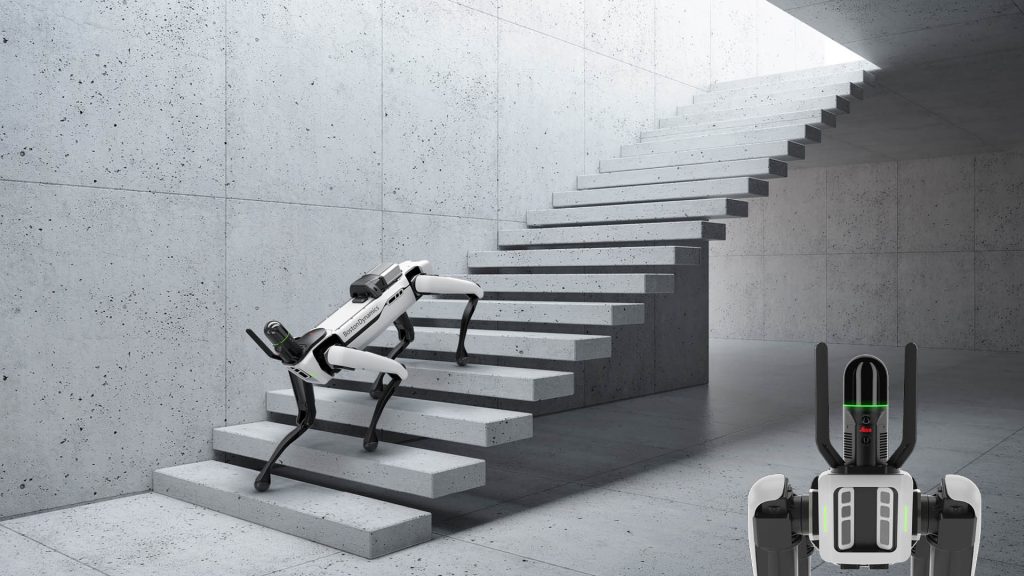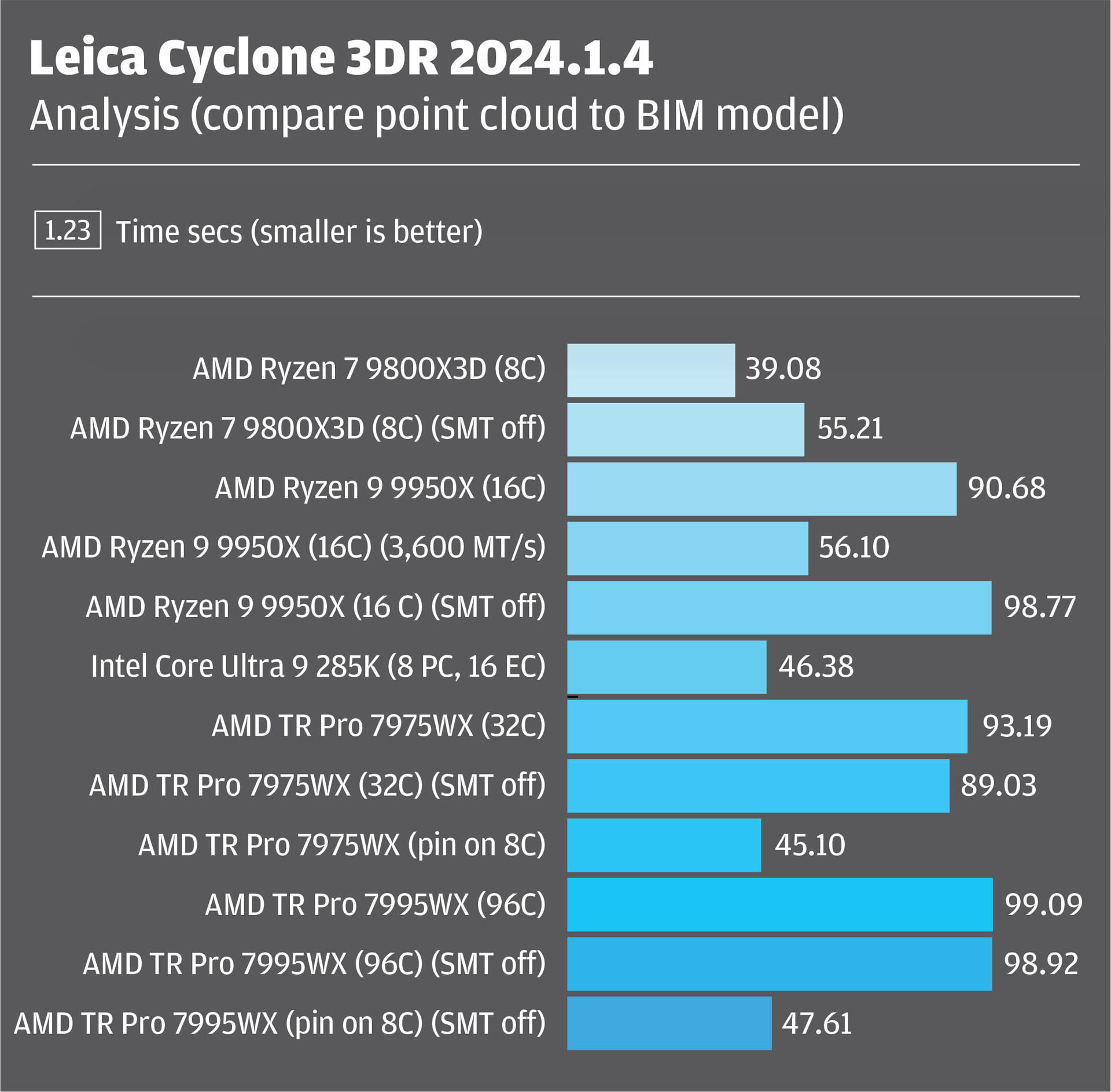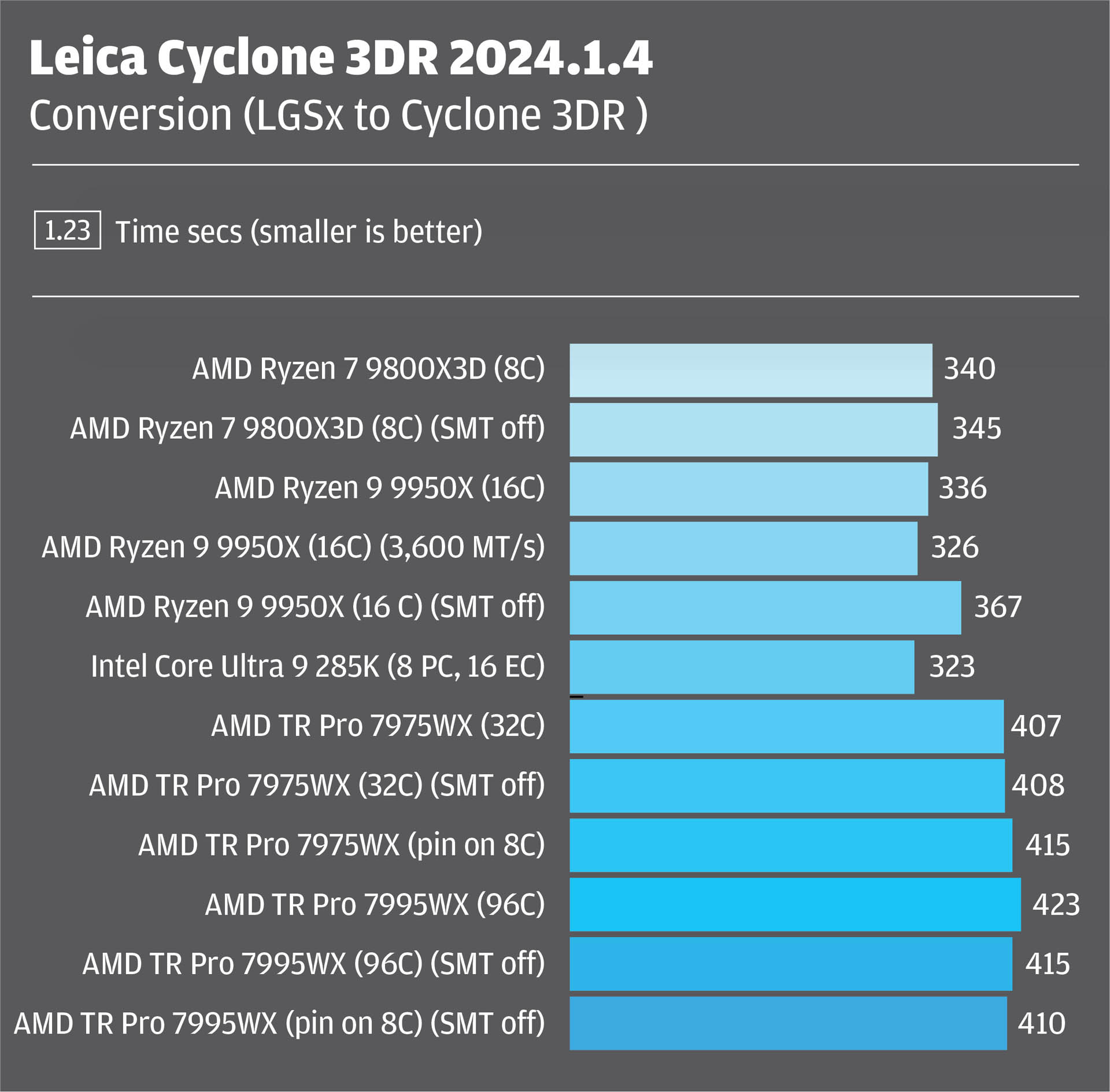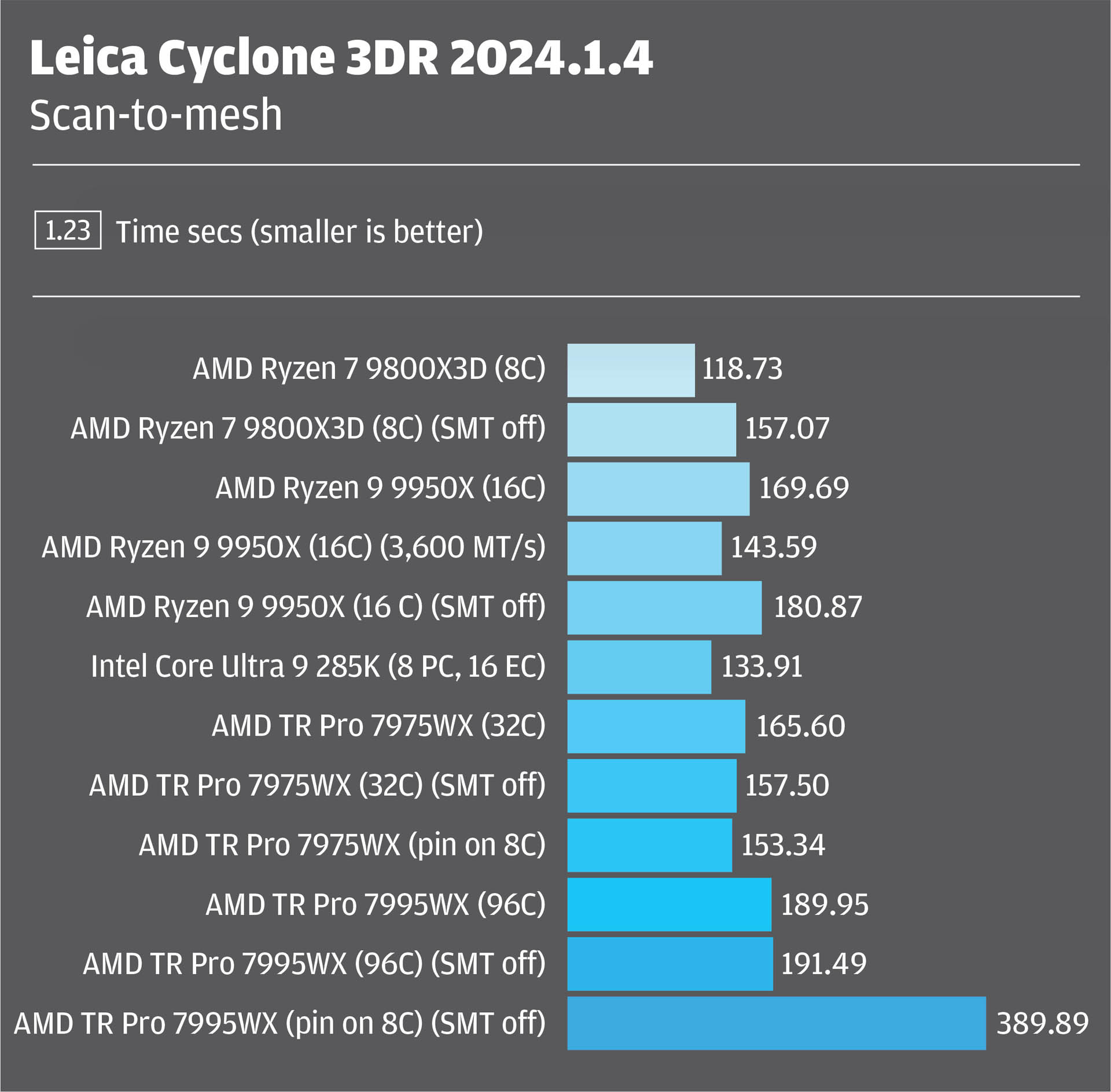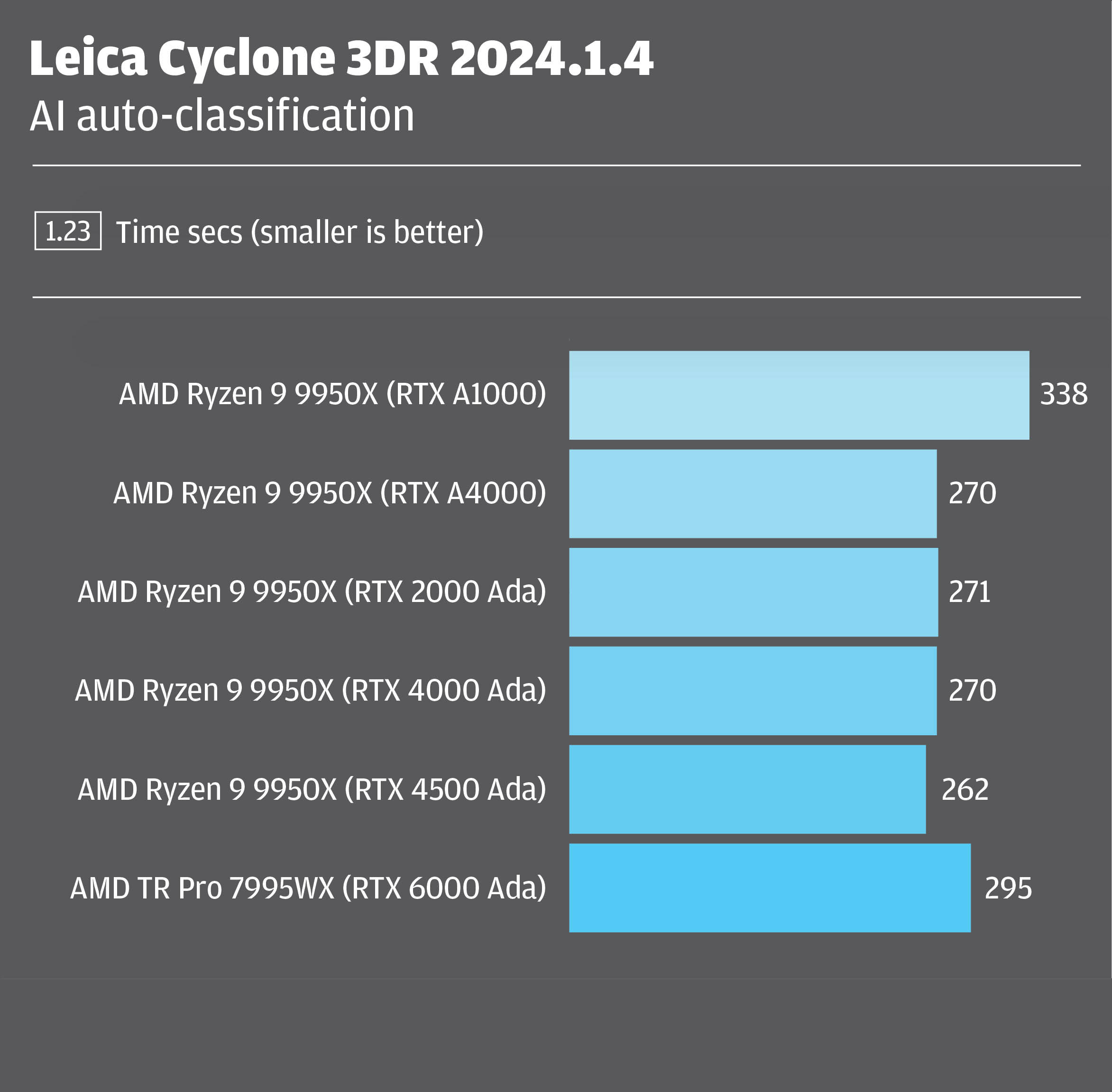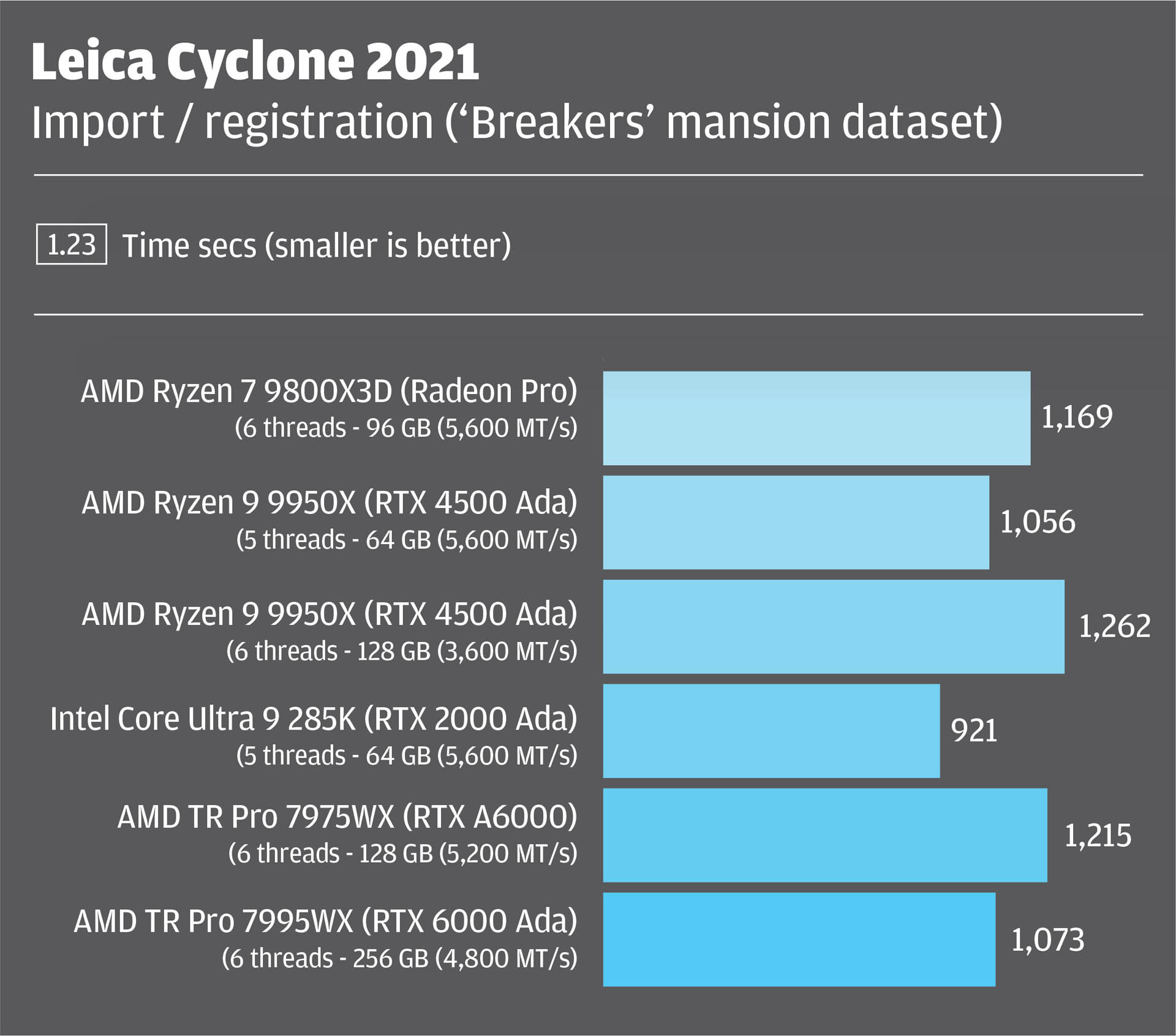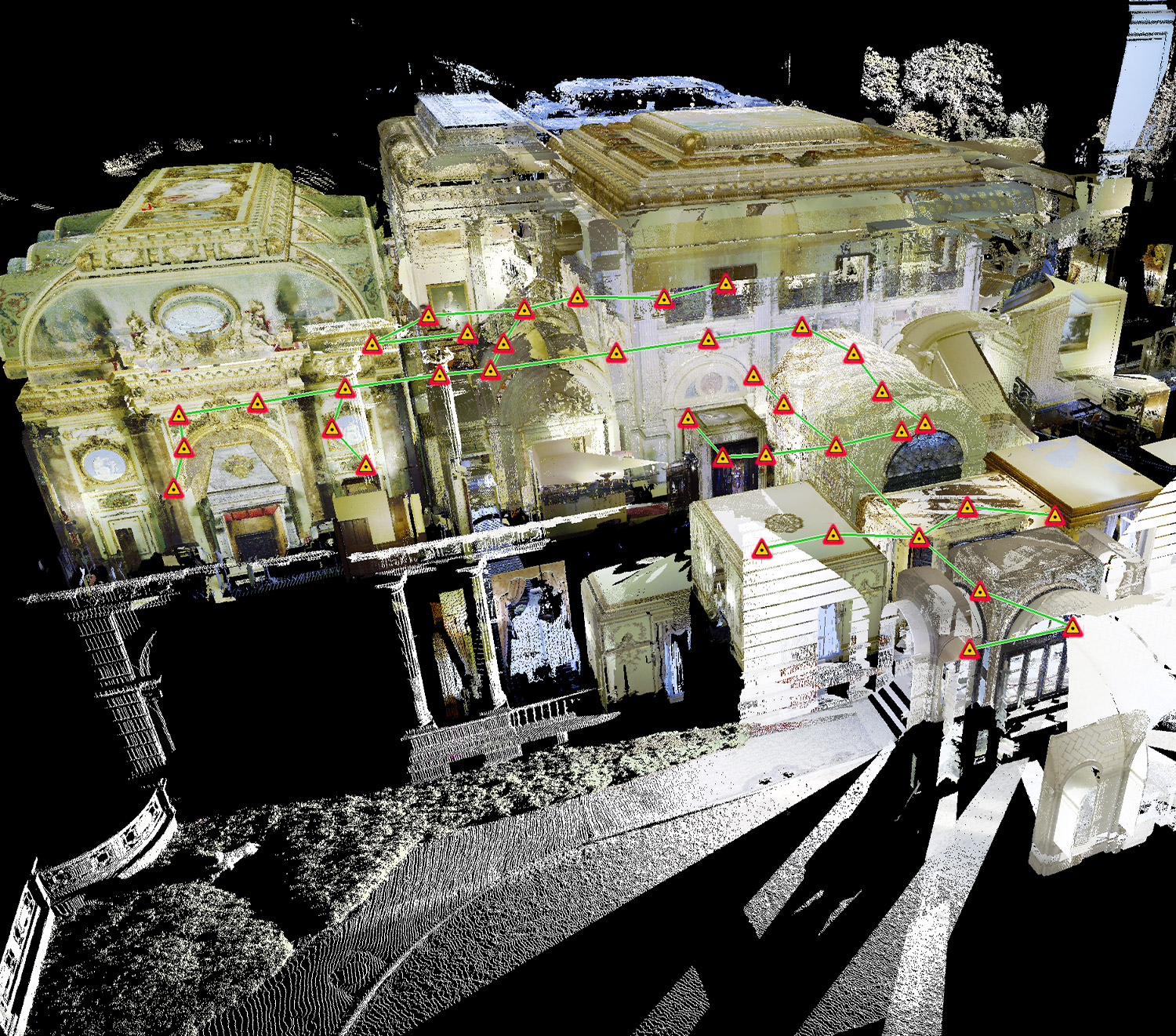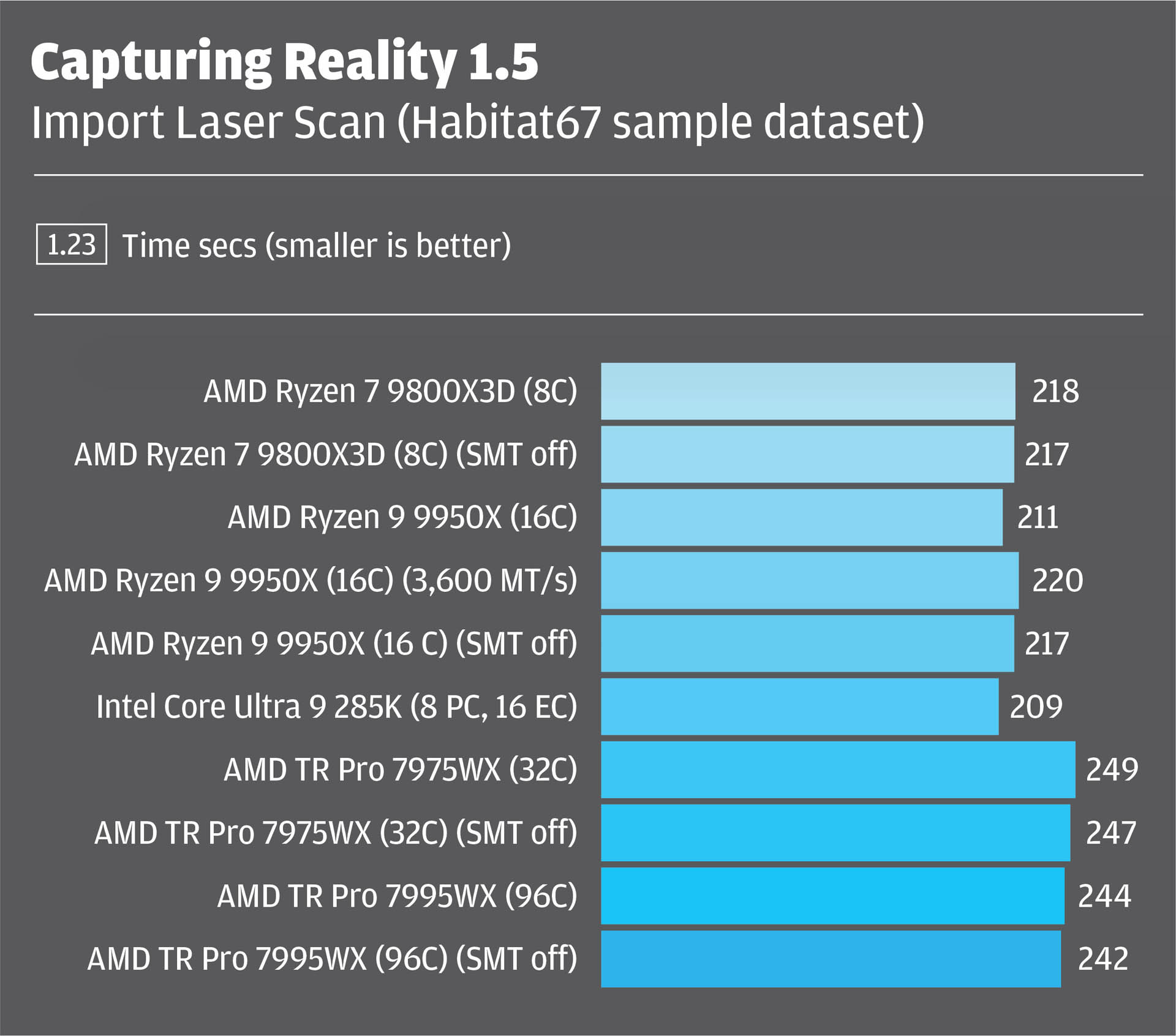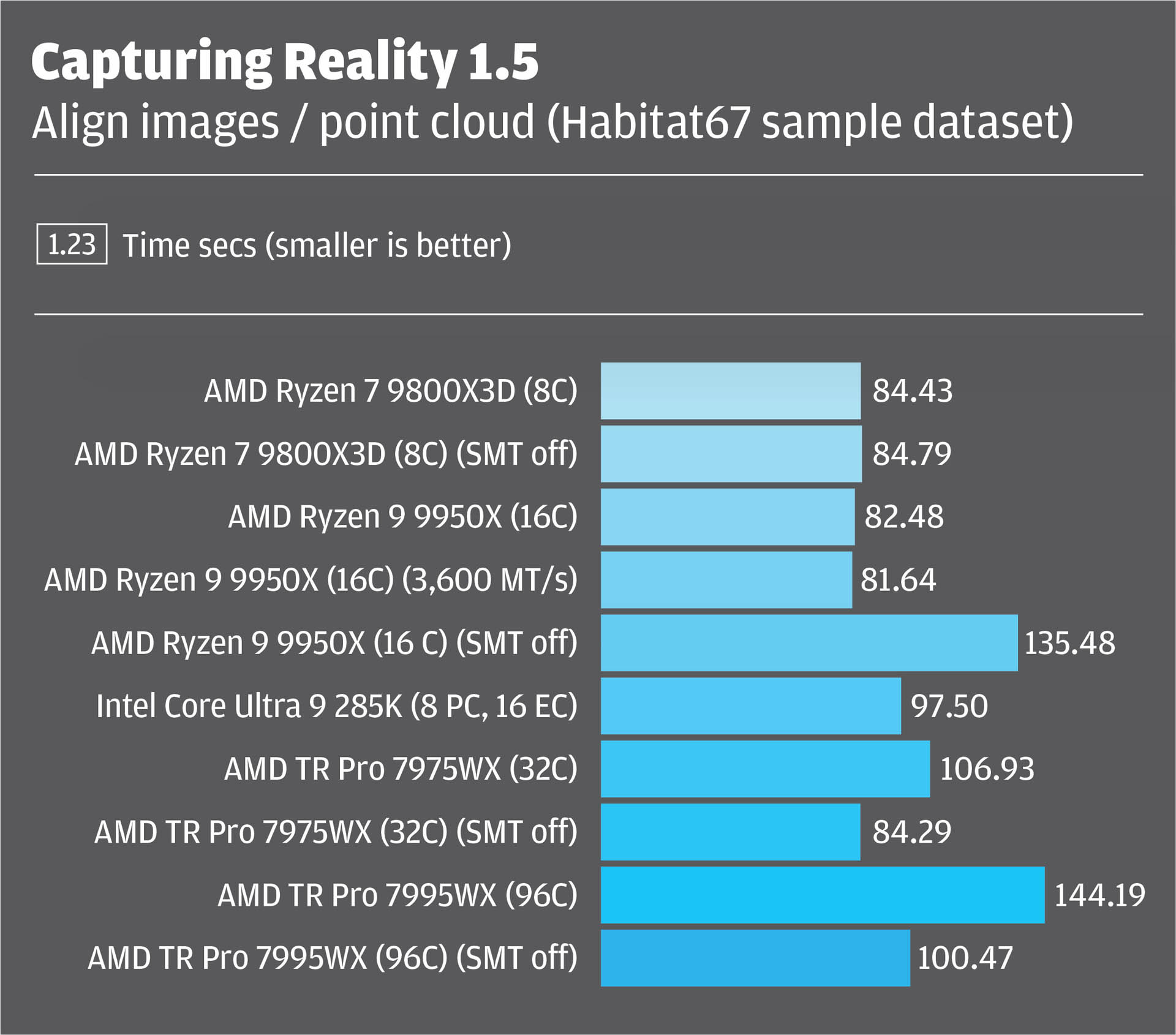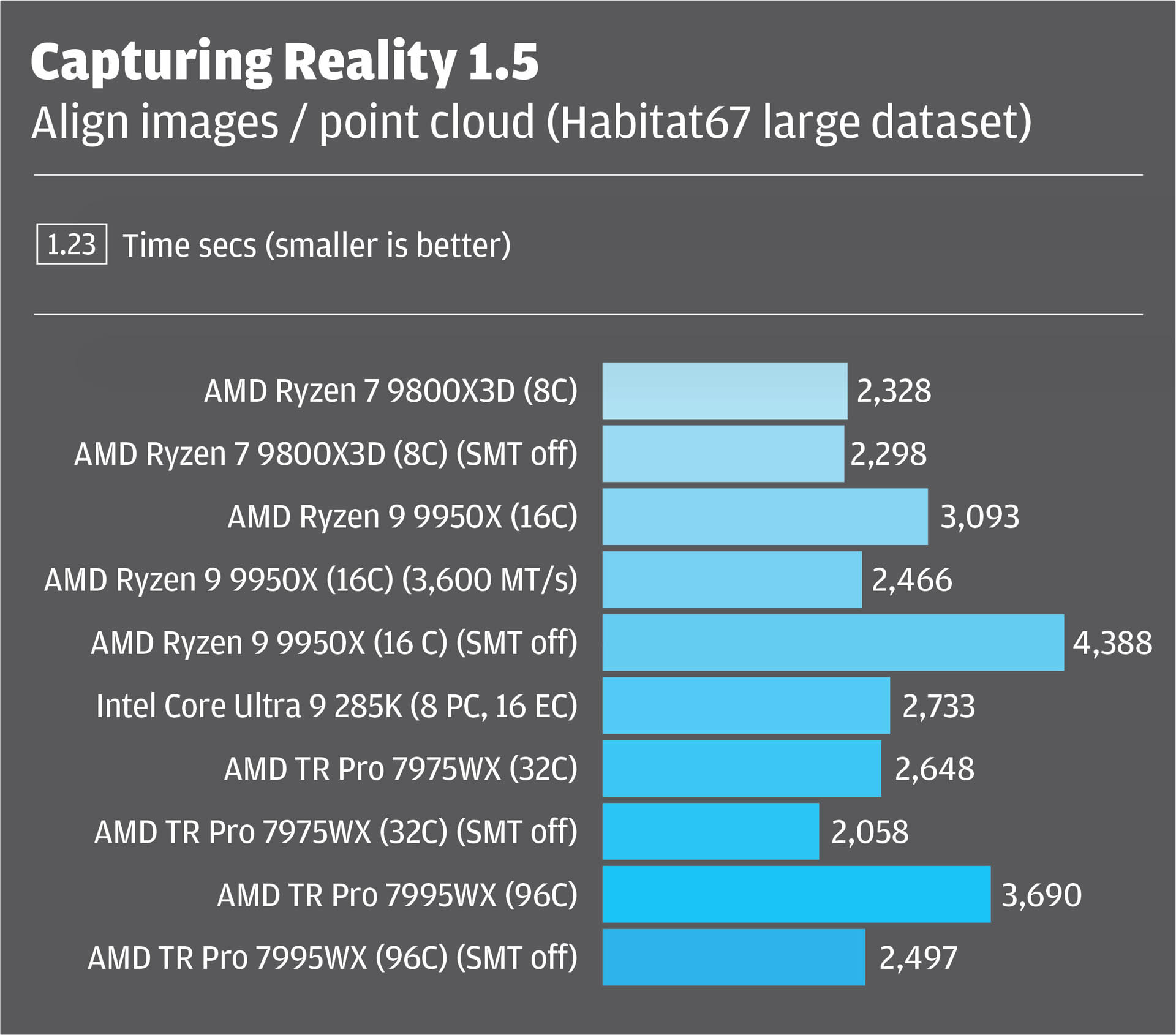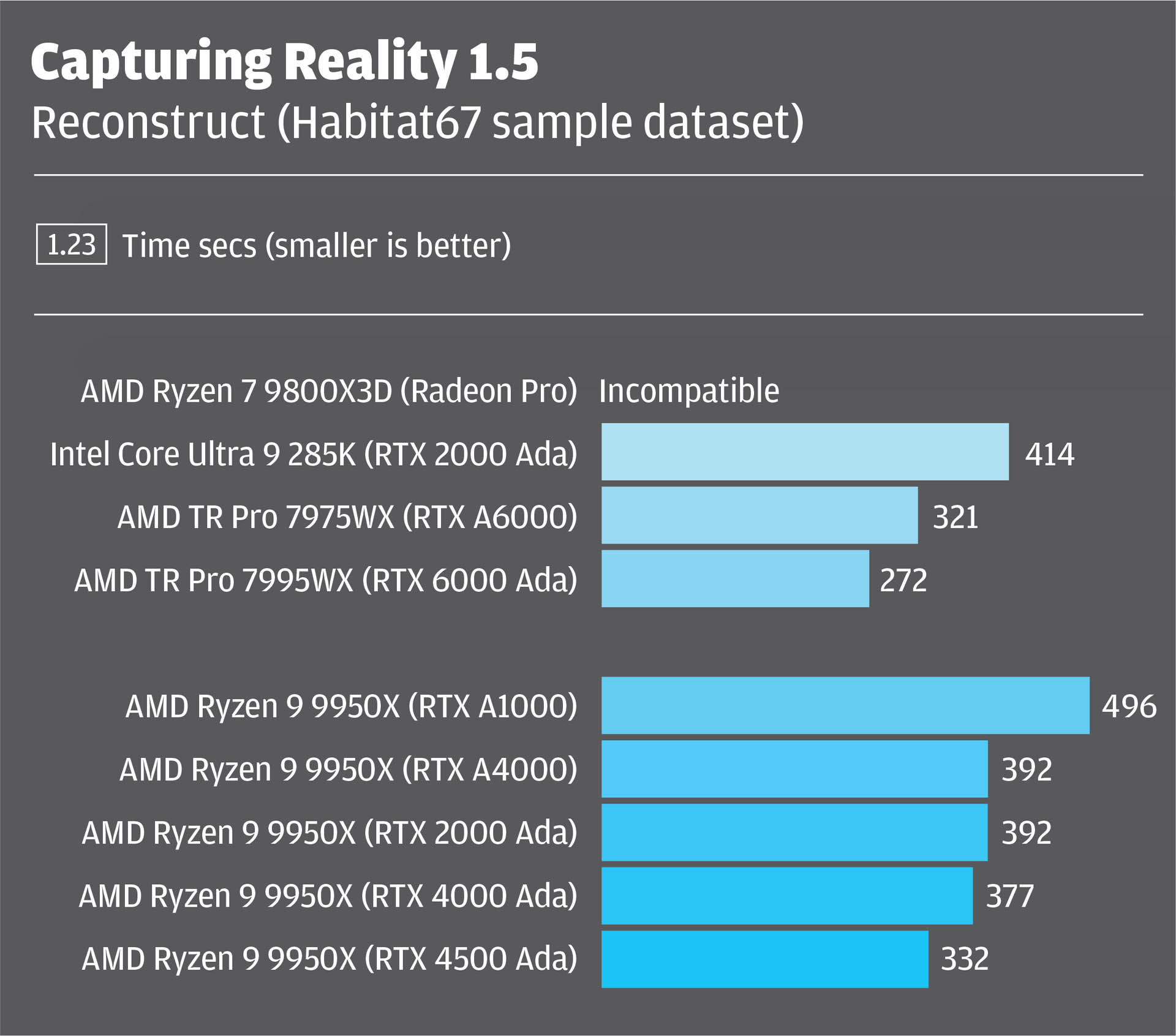What’s the best CPU, memory and GPU to process complex reality modelling data? Greg Corke tests some of the latest workstation technology in Leica Cyclone 3DR, Leica Cyclone Register 360, and RealityCapture from Epic Games
Reality modelling is one of the most computationally demanding workflows in Architecture, Engineering and Construction (AEC). It involves the creation of digital models of physical assets by processing vast quantities of captured real-world data using technologies including laser scanning, photogrammetry and simultaneous localisation and mapping (SLAM).
Reality modelling has numerous applications, including providing context for new buildings or infrastructure, forming the basis for retrofit projects, or comparing “as-built” with “as-designed” for construction verification.
This article is part of AEC Magazine’s 2025 Workstation Special report
While there’s a growing trend to process captured data in the cloud, desktop processing remains the preferred method. Cloud can be costly, and uploading vast amounts of data — sometimes terabytes — is a significant challenge, especially when working from remote construction sites with poor connectivity.
Processing reality capture data can take hours, making it essential to select the right workstation hardware. In this article, we explore the best processor, memory and GPU options for reality modelling, testing a variety of workflows in three of the most popular tools — Leica Cyclone 3DR, Leica Cyclone Register 360, and RealityCapture by Capturing Reality, a subsidiary of Epic Games.
Most AEC firms have tight hardware budgets and it’s easy to spend money in the wrong places, sometimes for very little gain. In some cases, investing in more expensive equipment can even slow you down!
Leica Cyclone 3DR
Leica Cyclone 3DR is a multi-purpose reality modelling tool, used for inspection, modelling and meshing. Processing is done predominantly on the CPU and several tasks can take advantage of multiple CPU cores. Some tasks, including the use of machine learning for point cloud classification, are also optimised for GPU.
For testing we focused on four workflows: scan-to-mesh, analysis, AI classification and conversion.
Scan-to-mesh: Compared to point clouds, textured mesh models are much easier to understand and easier to share, not least because the files are much smaller.
In our ‘scan-to-mesh’ test, we record the time it takes to convert a dataset of a building — captured with a Leica BLK 360 scanner — into a photorealistic mesh model. The dataset comprises a point cloud with 129 million points and accompanying images.
The process is multi-threaded but, as with many reality capture workflows, more CPU cores does not necessarily mean faster results. Other critical factors that affect processing time include the amount of CPU cache (a high-speed onchip memory for frequently accessed data), memory speed, and AMD Simultaneous Multithreading (SMT), a technology similar to Intel Hyper-Threading that enables a single physical core to execute multiple threads simultaneously. During testing, system memory usage peaked at 25 GB, which meant all test machines had plenty of capacity.
The most unexpected outcome was the 8-core AMD Ryzen 7 9800X3D outperforming all its competitors. It not only beat the 16-core AMD Ryzen 9 9950X and Intel Core Ultra 9 285K (8 performance cores and 16 efficient cores), but the multicore behemoths as well. With the 96- core AMD Threadripper Pro 7995WX it appears to be a classic case of “too many cooks [cores] spoil the broth”!
The AMD Ryzen 7 9800X3D is a specialised consumer CPU, widely considered to be the fastest processor for 3D gaming thanks to its advanced 3D V-Cache technology. It boasts 96 MB of L3 cache, significantly more than comparative processors. This allows the CPU to access frequently-used data quicker, rather than having to pull it from slower system memory (RAM).
But we expect that having lots of fast cache is not the only reason why the AMD Ryzen 7 9800X3D comes out top in our scan-to-mesh test – after all, Threadripper Pro is also well loaded, with the top-end 7995WX having 384 MB of L3 cache which is spread across its 96 cores. To achieve a high number of cores, modern processors are made up of multiple chiplets or CCDs. In the world of AMD, each CCD typically has 8 cores, so a 16- core processor has two CCDs, a 32-core processor has four CCDs, and so on.
Communication between cores in different CCDs is inherently slower than cores within the same CCD, and since the AMD Ryzen 7 9800X3D is made up of a single CCD that has access to all that L3 cache, we expect this gives it an additional advantage. It will be interesting to see how the recently announced 12-core Ryzen 9 9900X3D and 16-core Ryzen 9 9950X3D compare. Both processors feature 128 MB of L3 cache and comprise two CCDs.
Simultaneous Multithreading (SMT) also has an impact on performance. With the AMD Ryzen 9 9950X, for example, disabling SMT in the BIOS cut processing time by as much as 15%. However, it had the opposite effect with the AMD Ryzen 7 9800X3D, increasing processing time by 32%.
Memory speed also has an impact on performance. The AMD Ryzen 9 9950X processor was around 7% slower when configured with 128 GB RAM running at 3,400 MT/sec than it was with 64 GB RAM running at the significantly faster 5,600 MT/sec.
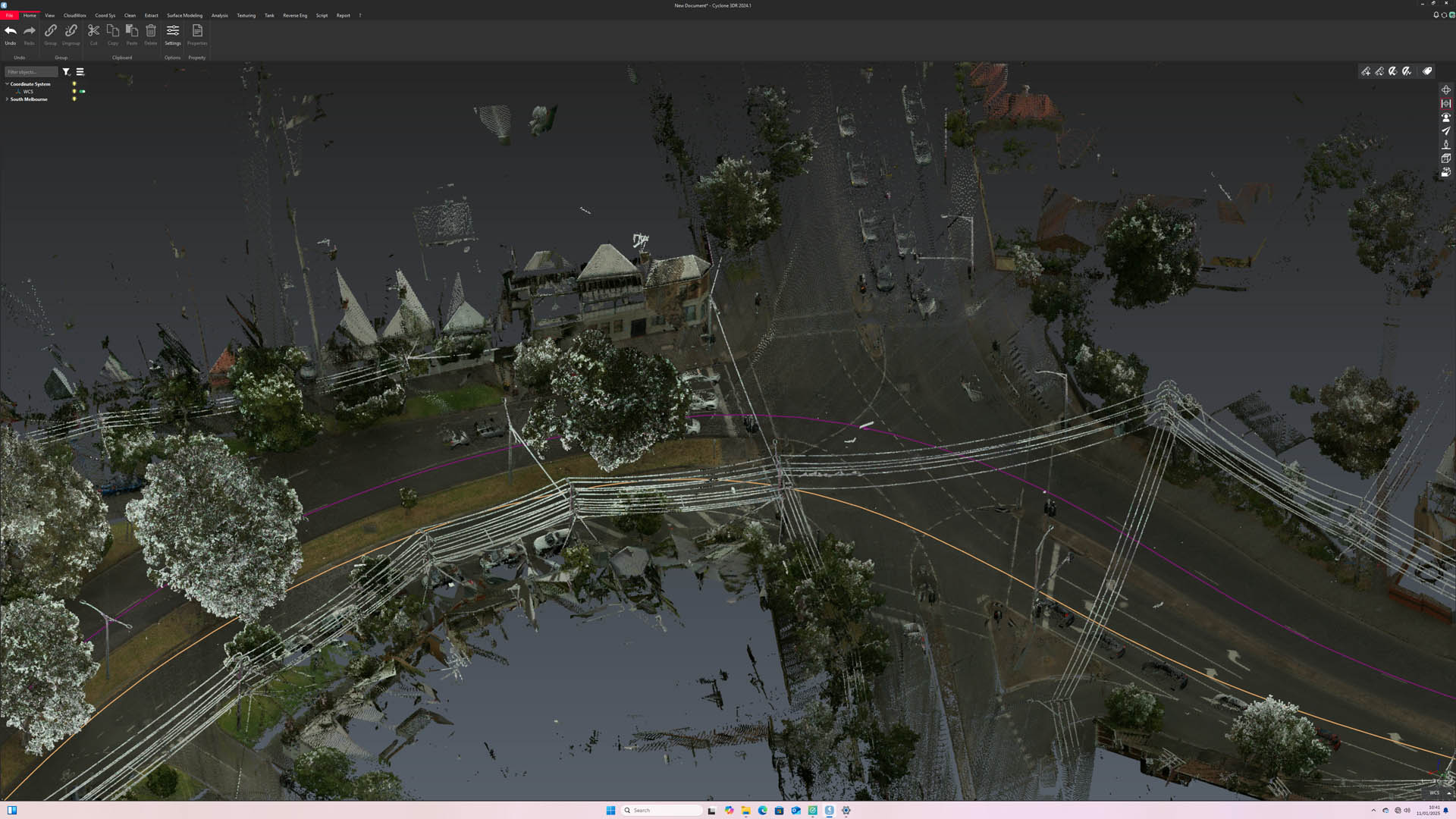
Analysis: In our analysis test we compare a point cloud to a BIM model, recording the time it takes to calculate a colour map that shows the deviations between the two datasets. During testing, system memory usage peaked at 19 GB.
The process is multi-threaded, but certain stages only use a few cores. As with scan-to-mesh, more CPU cores does not necessarily mean faster results, and CPU cache, SMT and memory speed also play an important role. Again, the AMD Ryzen 7 9800X3D bagged first spot, completing the test 16% faster than its closest rival, the Intel Core Ultra 9 285K.
The big shock came from the 16-core AMD Ryzen 9 9950X, which took more than twice as long as the 8-core AMD Ryzen 7 9800X3D to complete the test. The bottleneck here is SMT, as disabling it in the BIOS, so each of the 16 cores only performs one task at a time, slashed the test time from 91 secs to 56 secs.
Getting good performance out of the Threadripper Pro processors required even more tuning. Disabling SMT on its own had a minimal impact, and it was only when the Cyclone 3DR executable was pinned to a single CCD (8 cores, 16 threads) that times came down. But this level of optimisation is probably not practical, not least because all workflows and datasets are different.
AI classification: Leica Cyclone 3DR features an AI-based auto-classification algorithm designed to ‘intelligently classify’ point cloud data. The machine learning model has been trained on large amounts of terrestrial scan data and comes with several predefined models for classification.
Two of our test workflows rely on Nvidia GPUs, but because they share some of the workload with the CPU, the performance gains from more powerful GPUs are less pronounced compared to entirely GPU-driven tasks like ray trace rendering
The process is built around Nvidia CUDA and therefore requires an Nvidia GPU. However, the CPU is still used heavily throughout the process. We tested a variety of Nvidia RTX professional GPUs using an AMD Ryzen 9 9950X-based workstation with 64 GB of DDR5 memory.
The test records the time it takes to classify a point cloud of a building with 129 million points using the Indoor Construction Site 1.3 machine learning model. During testing, system memory usage peaked at 37 GB and GPU memory usage at a moderate 3 GB.
The big takeaway from our tests is that the CPU does the lion’s share of the processing. The Nvidia RTX GPU is essential, but only contributes modestly to the overall time. Indeed, there was very little difference between most of the Nvidia RTX GPUs and even the entry-level Nvidia RTX A1000 was only 22% slower than the significantly more powerful Nvidia RTX 4500 Ada.
Conversion: This simple test converts a Leica LGSx file into native Cyclone 3DR. The dataset comprises a point cloud of a highway alignment with 594 million points. During testing, system memory usage peaked at 11 GB. As this process is largely single threaded it’s all about single core CPU performance. Here, the Intel Core Ultra 9 285K takes first place, closely followed by the AMD Ryzen 9 9950X in second. With a slightly slower peak frequency the AMD Ryzen 7 9800X3D comes in third. In this case, the larger L3 cache appear to offer no benefit.
The Threadripper Pro 7975WX and Threadripper Pro 7995WX lag behind — not only because they have a lower frequency, but are based on AMD’s older ‘Zen 4’ architecture, so have a lower Instructions Per Clock (IPC).
Leica Cyclone Register 360
Leica Cyclone Register 360 is specifically designed for point cloud registration, the process of aligning and merging multiple point clouds into a single, unified coordinate system.
For testing, we used a 99 GB dataset of the Italian Renaissance-style ‘Breakers’ mansion in Newport, Rhode Island. It includes a total of 39 setups from a Leica RTC360 scanner, around 500 million points and 5K panos. We recorded the time it takes to import and register the data.
The process is multi-threaded, but to ensure stability the software allocates a specific number of threads depending on how much system memory is available. In 64 GB systems, the software allocates five threads while for 96 GB+ systems it’s six.
The Intel Core Ultra 9 285K processor led by some margin, followed by the 16- core AMD Ryzen 9 9950X and 96-core Threadripper Pro 7995WX. Interestingly, this was the one test where the 8-core AMD Ryzen 7 9800X3D was not one of the best performers. However, as the GPU does a small amount of processing, and Leica Cyclone Register 360 has a preference for Nvidia GPUs, this could be attributed to the workstation having the entry-level AMD Radeon Pro W7500 GPU.
Notably, memory speed appears to play a crucial role in performance. The AMD Ryzen 9 9950X, configured with 128 GB of 3,400 MT/sec memory, was able to utilise six threads for the process, but was 20% slower than when configured with 64 GB of faster 5,600 MT/sec memory, which only allocated five threads.
RealityCapture from Epic Games
RealityCapture, developed by Capturing Reality — a subsidiary of Epic Games — is an advanced photogrammetry software designed to create 3D models from photographs and laser scans. Most tasks are accelerated by the CPU, but there are certain workflows that also rely on GPU computation.
Image alignment in RealityCapture refers to the process of analysing and arranging a set of photographs or scans in a 3D space, based on their spatial relationships. This step is foundational in photogrammetry workflows, as it determines the relative positions and orientations of the cameras or devices that captured the input data.
We tested with two datasets scanned by R-E-A-L.iT, Leo Films, Drone Services Canada Inc, both available from the RealityCapture website.
The Habitat 67 Hillside Unreal Engine sample project features 3,199 images totalling 40 GB, 1,242 terrestrial laser scans totalling 90 GB, and uses up 60 GB of system memory during testing. The Habitat 67 Sample, a subset of the larger dataset, features 458 images totalling 3.5 GB, 72 terrestrial laser scans totalling 3.35 GB, and uses up 13 GB of system memory.
The 32-core Threadripper Pro 7975WX took top spot in the large dataset test, with the AMD Ryzen 9 9950X, AMD Ryzen 7 9800X3D and 96-core AMD Threadripper Pro 7995WX not that far behind. Again, SMT needed to be disabled in the higher core count CPUs to get the best results.
Memory speed appears to have a huge impact on performance. The AMD Ryzen 9 9950X processor was around 40% slower when configured with 128 GB of RAM running at 3,400 MT/sec than it was with 64 GB running at the significantly faster 5,600 MT/sec.
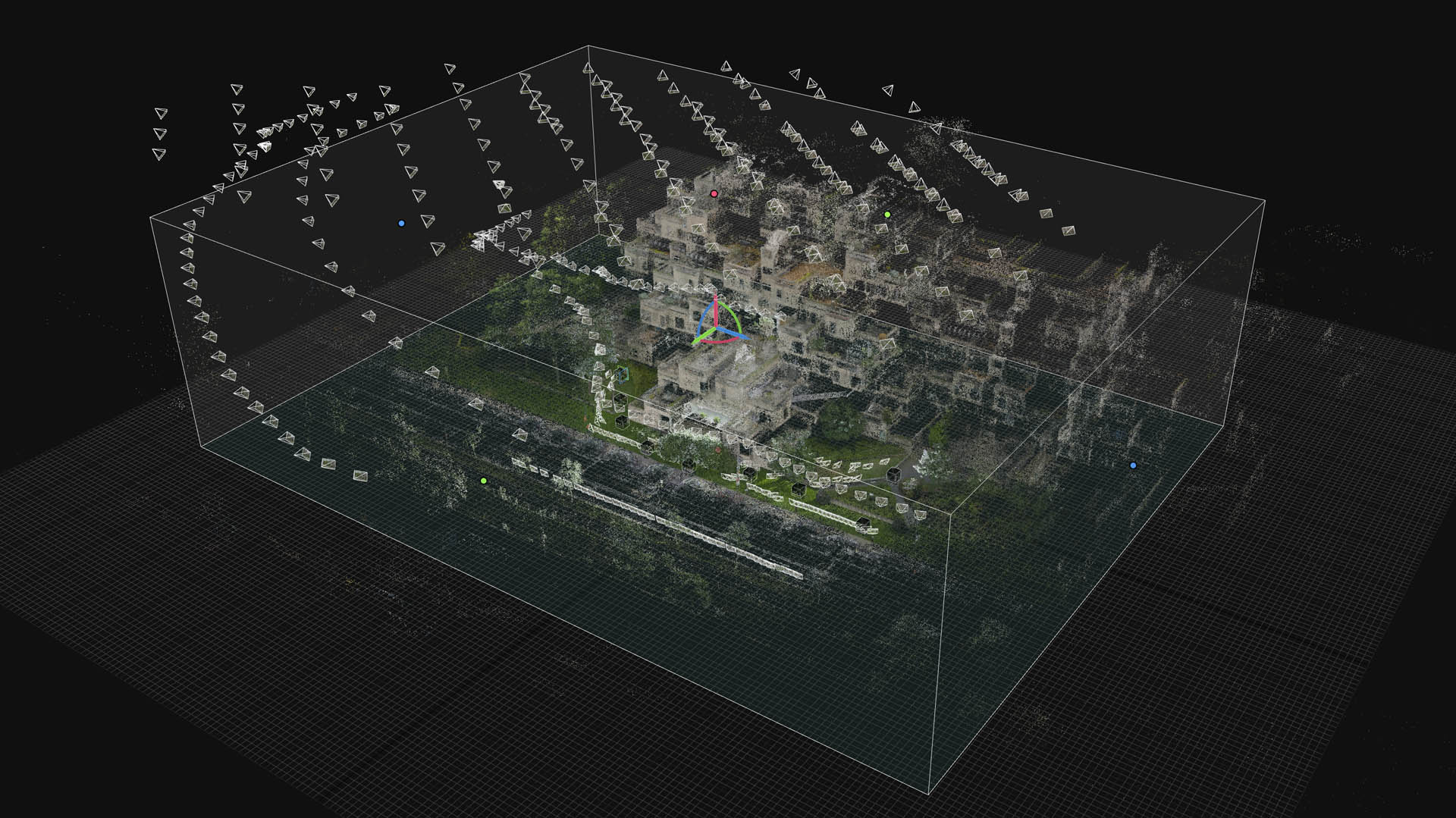
Import laser scan: This process imports a collection of E57 format laser scan data and converts it into a RealityCapture point cloud with the .lsp file extension. Our test used up 13 GB of system memory.
Since this process relies heavily on single-threaded performance, single-core speed is what matters most. The Intel Core Ultra 9 285K comes out on top, followed closely by the AMD Ryzen 9 9950X. With a slightly lower peak frequency, the AMD Ryzen 7 9800X3D takes third place. The Threadripper Pro 7975WX and 7995WX fall behind, not just due to lower clock speeds but also because they’re built on AMD’s older Zen 4 architecture, which has a lower Instructions Per Clock (IPC).
Reconstruction is a very compute intensive process that involves the creation of a watertight mesh. It uses a combination of CPU and Nvidia GPU, although there’s also a ‘preview mode’ which is CPU only.
For our testing, we used the Habitat 67 Sample dataset at ‘Normal’ level of detail. It used 46 GB of system memory and 2 GB of GPU memory.
With a variety of workstations with different processors and GPUs, it’s hard to pin down exactly which processor is best for this workflow — although the 96-core Threadripper Pro 7995WX workstation with Nvidia RTX 6000 Ada GPU came out top. To provide more clarity on GPUs, we tested a variety of add-in boards in the same AMD Ryzen 9 9950X workstation. There was relatively good performance scaling across the mainstream Nvidia RTX range.
Thoughts on processors / memory
The combination of AMD’s ‘Zen 5’ architecture, fast DDR5 memory, a single chiplet design, and lots of 3D V-Cache, looks to make the AMD Ryzen 7 9800X3D processor a very interesting option for a range of reality modelling workflows — especially for those on a budget. The AMD Ryzen 7 9800X3D becomes even more interesting when you consider that it’s widely regarded to be for gamers. The chip is not offered by any of the major workstation OEMs — only specialist system builders like Armari.
However, before you rush out and part with your hard-earned cash, it is important to understand a few things.
1) The AMD Ryzen 7 9800X3D processor currently has a practical maximum capacity of 96 GB, if you want fast 5,600 MT/sec memory. This is an important consideration if you work with large datasets. If you run out of memory, the processor will have to swap data out to the SSD, which will likely slow things down considerably.
The AMD Ryzen 9 9800X3D can support up to 192 GB of system memory, but it will need to run at a significantly slower speed (3,600 MT/sec). And as our tests have shown, slower memory can have a big impact on performance.
2) AMD recently announced two additional ‘Zen 5’ 3D V-Cache processors. It will be interesting to see how they compare. The 12-core Ryzen 9 9900X3D and 16-core Ryzen 9 9950X3D both have slightly more L3 cache (128 MB) than the 8-core Ryzen 7 9800X3D (96 MB). However, they are made up of two separate chiplets (CCDs), so communication between the cores in different CCDs could slow things down.
3) Most of the reality models we used for testing are not that big, with the exception of the Habitat 67 dataset, which we used to test certain aspects of RealityCapture. Larger datasets require more memory. For example, reconstructing the full Habitat 67 RealityCapture dataset on the 96-core Threadripper Pro 7995WX workstation used 228 GB of system memory at peak, out of the 256 GB in the machine – and took more than half a day to process. Workstations with less system memory will likely have to push some of the data into temporary swap space on the SSD. Admittedly, as modern PCIe NVMe SSDs offer very fast read-write performance, this is not necessarily the colossal bottleneck it used to be when you had to swap out data to mechanical Hard Disk Drives (HDDs).
4) Multi-tasking is often important for reality modelling, as the processing of data often involves several different stages from several different sources. At any given point you may need to perform multiple operations at the same time, which can put a massive strain on the workstation. As the AMD Ryzen 7 9800X3D processor has only 8-cores and is effectively limited to 96 GB of fast system memory, if you throw more than one task at the machine at a time things will likely slow down considerably. Meanwhile Threadripper Pro is much more scalable as there are processors with 12- to 96-cores, and the platform supports up to 2 TB of DDR5-5200 ECC memory.
For a crude multi-tasking test, we performed two operations in parallel — alignment in RealityCapture and meshing in Leica Cyclone 3DR. The Threadripper Pro 7995WX workstation completed both tests in 200 secs, while AMD Ryzen 7 9800X3D came in second in 238 secs. We expect this lead would grow with larger datasets or more concurrent processing tasks.
In summary, your choice of processor will depend greatly on the size of datasets you work with, and the complexity of your workflows. For lighter tasks, the AMD Ryzen 7 9800X3D looks to be an excellent budget choice, but for more complex projects, especially those that require multi-tasking, Threadripper Pro should deliver a much more flexible and performant platform. Of course, you still need to choose between the different models, which vary in price considerably and, as we have found in some of our tests, fewer cores is sometimes better.
Thoughts on GPUs
Two of our tests — Reconstruction in RealityCapture and AI classification in Leica Cyclone 3DR — rely on Nvidia GPUs. However, because these processes share some of the workload with the CPU, the performance gains from more powerful GPUs are less pronounced compared to entirely GPU-driven tasks like ray trace rendering.
There’s a significant price gap between the Nvidia RTX A1000 (£320) and the Nvidia RTX 6000 Ada Generation (£6,200). For reconstruction in RealityCapture, investing in the higher-end model is probably easier to justify, as our tests showed computation times could be cut in two. However, for AI classification in Leica Cyclone 3DR, the performance gains are much smaller, and there seem to be diminishing returns beyond the Nvidia RTX 2000 Ada Generation.
While larger datasets may deliver more substantial benefits, GPU memory — a key advantage of the higher-end cards — appears to be less crucial.
Workstation technology on test
Below is a list of kit we used for testing. All machines were Windows 11 Pro 26100.
Armari Magnetar workstation with AMD Ryzen 7 9800X3D CPU (8 cores), 96 GB DDR5 5,600 MT/s memory and AMD Radeon Pro W7500 GPU (read our review).
Scan 3XS workstation with AMD Ryzen 9 9950X CPU (16 cores), 64 GB DDR5 5,600 MT/s memory or 128 GB DDR5 3,600 MT/s memory and Nvidia RTX 4500 Ada Generation GPU (read our review).
Scan 3XS workstation with Intel Core Ultra 9 285K CPU (8 P-cores and 16 E-cores), 64 GB DDR5 5,600 MT/s memory and Nvidia RTX 2000 Ada Generation GPU (read our review).
HP Z6 G5A workstation with AMD Threadripper Pro 7975WX CPU (32 cores), 128 GB DDR5 5,200 MT/s memory and Nvidia RTX A6000 GPU (read our review).
Comino Grando workstation with overclocked AMD Threadripper Pro 7995WX CPU (96 cores), 256 GB DDR5 4,800 MT/s memory and Nvidia RTX 6000 Ada Generation GPU. (read our review).
We also tested a range of GPUs, including the Nvidia RTX A1000 (8 GB), RTX A4000 (16 GB), RTX 2000 Ada (16 GB), RTX 4000 Ada (20 GB), RTX 4500 Ada (24 GB) and RTX 6000 Ada (48 GB).
Main image: Reality modelling data comes from multiple sources: the Leica BLK ARC autonomous laser scanning module riding steady on the Boston Dynamics Spot robot
This article is part of AEC Magazine’s 2025 Workstation Special report
- Features
- AMD Ryzen AI Max Pro: the integrated GPU comes of age
- AMD Ryzen 9000 vs Intel Core Ultra 200S
- Workstations for arch viz
- The AI enigma – challenges for workstations
- Nvidia RTX GPUs for Stable Diffusion
- Z by HP Boost: GPUs on demand
- Workstations for reality modelling
Reviews
- HP ZBook Firefly 14 G11 A mobile workstation
- Lenovo ThinkPad P14s (AMD) mobile workstation
- Scan 3XS GWP-A1-C24 and GWP-A1-R32 desktop workstations
- Boxx Apexx A3 desktop workstation
- Armari Magnetar MM16R9 desktop workstation
- Comino Grando workstation RM
News
- Reshuffle spells end for Dell Precision workstation brand
- Lenovo powers IMSCAD workstation as a service (WaaS)
- Nvidia unveils ‘Blackwell’ RTX GPUs
- HP to launch 18-inch mobile workstation
- Nvidia reveals AI workstation
- HP bets big on AMD Ryzen AI Max PRO processor
- Intel Core Ultra 200HX and 200H processors launch
- AMD Ryzen AI Max PRO ‘Strix Halo’ processor launches

